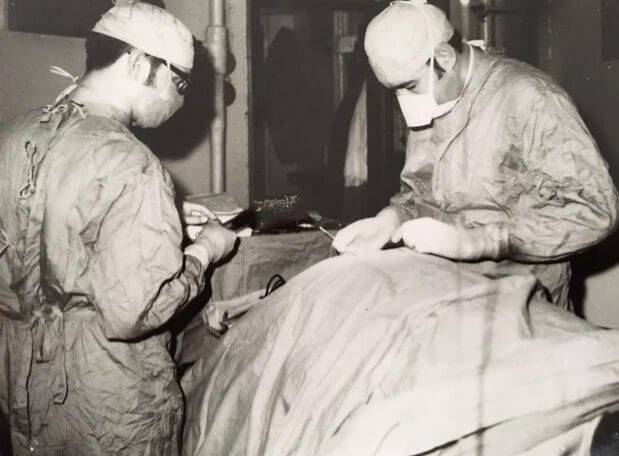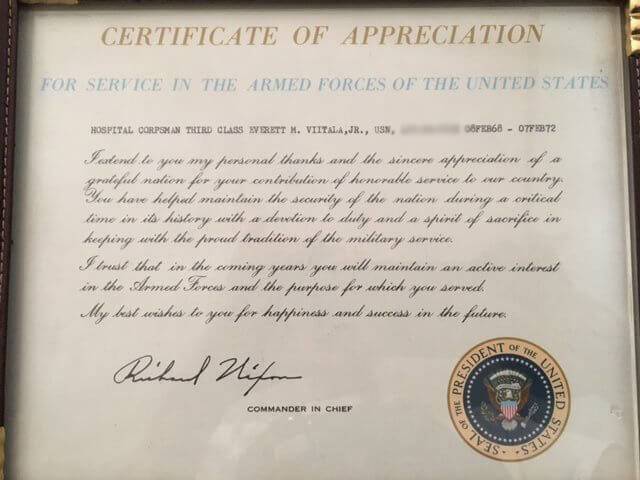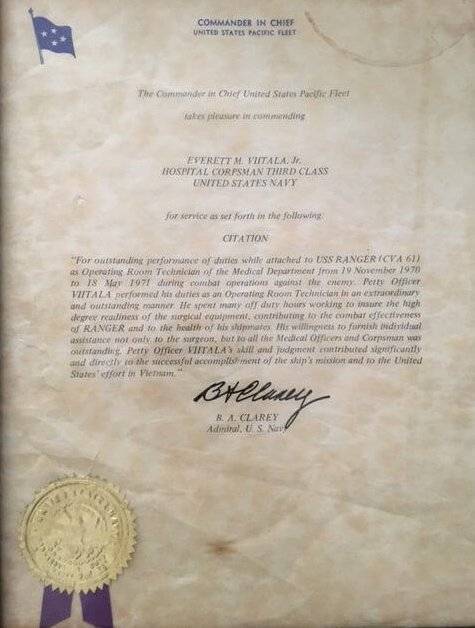
 A Minnesota PBS Initiative
A Minnesota PBS Initiative
I served as Navy Sailor, Hospital Corpsman, Operating Room Technician from 7 February 1968 to 7 February 1972.
First assignment was Building 26 2C, Balboa Naval Hospital, San Diego, which was a Plastic Reconstructive Ward-Burn Unit. My partner and mentor, HM3 Robert Buswell and I worked together until I was sent to O.R. School.
After graduation in July of 1969 I got orders to NAS Twin Cities where I was stationed for 10 Months. Reason to get orders to the NAS is that I had Burn Patient experience and Operating Room experience. Those two things are important where the NAS was sharing the runways with the Minneapolis International Airport. Airline accidents involve both burns and trauma. It was the perfect place to use my skills if called upon.
On the day I reported to the NAS HM3 Robert Buswell was killed in country in Vietnam. He had been assigned to the Marines a few weeks before.
In June of 1970 to 7 February of 1972 I was stationed aboard the Aircraft Carrier USS Ranger CVA-61 as a Surgeon Mate. In October of 1970 we set sail for the Gulf of Tonkin. My duties were to assist the Surgeon, manage the main operating room and to manage the instrumentation in the battle aid stations.

Medically the ship had a capable compliment of 55 Hospital Corpsmen, 2 Flight Surgeons, 1 Senior Medical Officer, and 1 Surgeon. Flight Deck Aid was covered by squadron Corpsmen. My duties included first aid lecturing in many areas of the ship to qualify the crew for duty in a combat zone. Additionally I was the Corpsman in my duty section for fire call.
Occasionally I worked in "Sick Call" but mostly spent time in the Operating Room, keeping it ready for emergencies and elective surgery that did not interfere with the emergency readiness of our medical department, or comprising the ship's mission.
The team effort went far beyond the medical department. The Sailors in the Laundry Department cleaned and pressed all the laundry used in surgery. They even learned how to fold drapes and towels used in surgery. These were the unsung hero's during the cruise. The turn around for my linens was within a few hours. I delivered the linens and they delivered them back when they were done. If these fellows hadn't gone above and beyond to get these things laundered quickly there may have been shortcomings. But there wasn't. When emergencies occurred the Marine Compliment kept the passageways open to the Medical Department. These men were dedicated and devoted and did their duty above board, every time.
When surgery was commenced there was a sounding that there will be silence near the Operating Room. I called the ship's bridge to inform The ship's Captain that surgery was going to begin. The ship was held steady without making sharp turns. If a sharp turn was necessary or any movement that may interrupt the Surgeon the bridge would call to let us know. When surgery was completed I would call the bridge to let them know that surgery was over and the ship would then turn. Turning 80,000 tons of this city afloat meant that flight operations would bend the rules if they had to. And they did. All 5,500 men aboard the ship knew surgery was being performed. They all deserve a thank you for their hopes and prayers during the cruise.
I would call this a tremendous responsibility placed upon our group of young men who were well trained, well motivated and entirely dedicated to the health and welfare of every sailor on board.
We had casualties, and we had recoveries of both pilots and sailors who lost their lives on duty. Our Medical Department had to stay on line since the Hospital Ships USS Sanctuary and the USS Repose were pulled from the line and were decommissioned. During this time there were fewer Carriers on line.
My operating room was in the ready for our escort ships which also included merchant marine ships in case they needed surgical assistance and all ships were too far from port. Unlike civilian Medicine the Ranger was far from port, had a mission and it would take too much time to get a patient air lifted from the ship to a shore facility.
I did make plane requests and if the ship's mission was not compromised then a "Cod" would fly a patient off if within a time frame we could buy for the patient. Otherwise, we had to take care of the patient or patients on board. We did and we did it very well.
I would call this a tremendous responsibility placed upon our group of young men who were well trained, well motivated and entirely dedicated to the health and welfare of every sailor on board.
There is no need to give details, and as a Hospital Corpsman I am committed to refrain from graphic details.
It was the ultimate test of who I am, and what I could do to be brave, confident and knowing that the support was always there.
It is now a long time ago. But I live it every minute of every day. I wake at night sometimes with a flash of the past, but it passes for another night.
Most importantly the majority of sailors I served with and for are old guys like me. We try to remember the good, we try to remember the people who became our brothers.
To my Senior Enlisted, my fellow Corpsmen, the Nurses ashore, and Doctors I served with..... thank you for believing in me. It was the ultimate test of who I am, and what I could do to be brave, confident and knowing that the support was always there. I love them all.

It must be remembered that the most decorated rating in all the armed forces is Navy Hospital Corpsmen. Vietnam took many. Families still mourn their losses. Because of the time during this unpopular time in our History we can't forget the efforts. We did the best we could which was always better than best.

My children know the stories in some detail, but I have carried the reality of war to this day by myself, but shared with the people who served with me and with others during this era. There are many like us. Each of us carries the truth as we know it. And it is the truth. Vietnam was and is a tremendous effort. We can never forget that.
~ Butch Viitala HM3, USN.
Story Themes: 1968, 1969, 1970, 1971, 1972, Bear River, Brotherhood, Butch Viitala, Commendation, Corpsman, Death and Loss, Gulf of Tonkin, Medals of Honor, Medical Personnel, Navy, Relationships, San Diego, San Francisco, USS Ranger, Veterans of Foreign Wars, VFW